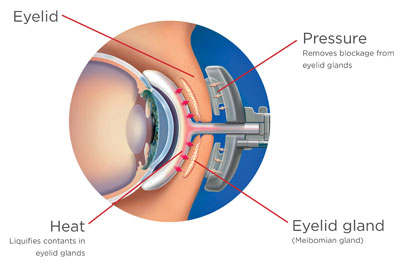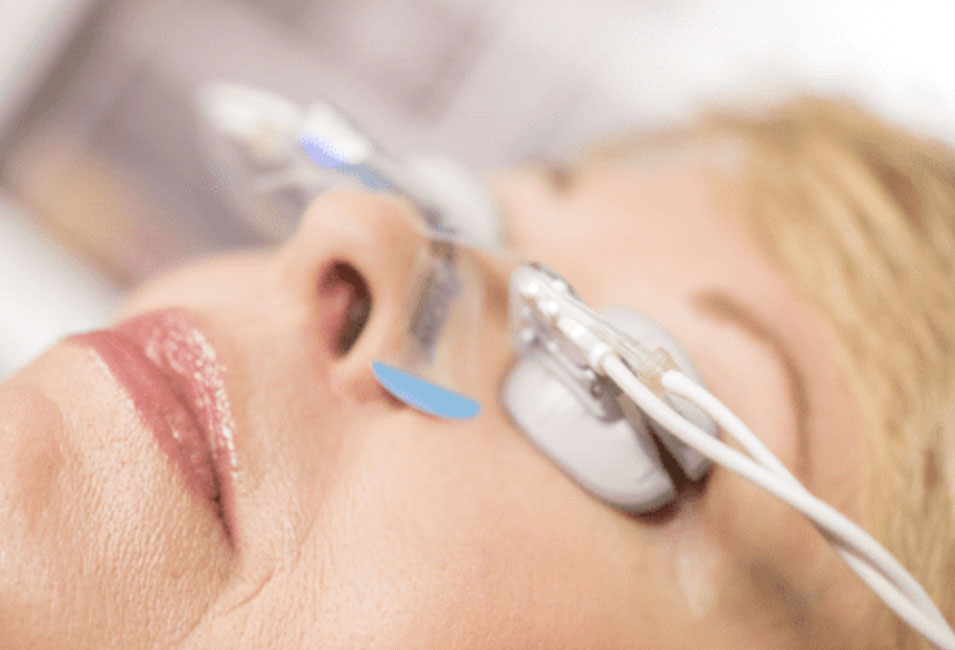
What is Dry Eye?
“Dry Eye” is a broad term used to describe problems with the tear layer that covers the eyes. Another (and probably more accurate) term to describe the condition is “Ocular Surface Disease.”
To understand dry eyes, it is important to first understand how tears work and how they are produced.
The majority of the tear film is composed of water – this is called the “aqueous layer.” The watery tears are produced by the lacrimal gland, located deep behind the upper eyelid.
Covering the aqueous layer is the “lipid layer.” This layer, made of oil, covers the aqueous layer, and prevents it from evaporating. The oil tears are made by eyelid glands called Meibomian glands.
The innermost tear layer is the “mucin layer,” which allows tears to adhere to the eye.
These three distinct layers work together to create a smooth and stable tear film.
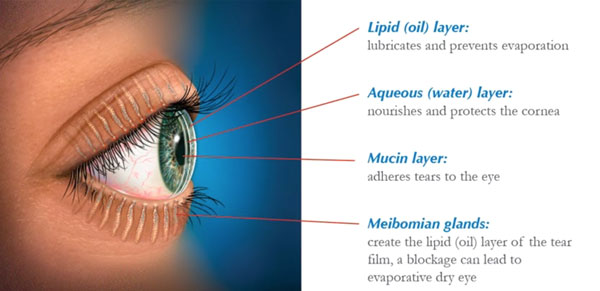

Take Our Dry Eye Self-Test
What are the symptoms of dry eyes?
Dry eye symptoms can vary, and they often create some confusion about their actual cause. The most common symptoms include burning, stinging, and gritty feeling eyes. These symptoms are often more common during prolonged staring activities like reading or computer use, or after exposure to wind or moving air created by fans.
Another very common symptom of dry eyes is excessive tearing. When the eyes become dry and irritated, it often triggers reflex watering of the eyes. These are not the quality and lasting tears that maintain comfortable eyes – they are thin, watery, “reflex” tears. They are the “emergency” tears that flow after the eyes have become dry and aggravated. Once this response has been triggered, it can sometimes last hours.
Often, dry eyes simply feel like there is something in the eye. Doctors call this “foreign body sensation.” No amount of rubbing or flushing the eyes seems to alleviate the awareness that something is in the eye.
Blurry vision – when the tear film on the eyes is inadequate, vision can fluctuate significantly. Blurred vision after reading for longer periods of time is often caused by dry eyes.
And finally, sometimes the eyes just feel dry. Lubricating drops are often used to supplement the lack of moisture in the eyes, but the problem never goes away.
What Causes Dry Eye?
It is very common that people suffering from dry eye disease have never been told why it is happening. There are many reasons for this, but most often it is because only a basic level of evaluation and treatment is being offered by most doctors. Dry eye management requires extensive training and experience, as well as advanced diagnostic and treatment instrumentation. Without these tools, a thorough and accurate assessment cannot be performed, and treatments cannot address the root cause of the problem. That is why it is so important to meet with a dry eye specialist to determine the cause of the problem and the best treatment plan. We are dry eye specialists.
The doctors at the Eye Care & Eye Wear Center of Maine specialize in the diagnosis and treatment of dry eye disease.

Common Causes of Chronic Dry Eyes
- The eyelids do not produce enough oily tears. This is called “meibomian gland disease,” and it accounts for over 85% of dry eye disease. Without the oily tear layer covering the tear film, the watery tears have no protection against evaporation. Doctors call this “evaporative dry eyes.” Poor meibomian gland function has many causes, which include:
• Rosacea (ocular rosacea)
• Decreased blinking – prolonged computer use or other visual tasks
• Demodex (skin mites infesting the eyelashes)
• Blepharitis (bacterial infection of the eyelid edges) - The lacrimal glands do not produce adequate watery (aqueous) tears – this is called aqueous deficiency, and it accounts for only a tenth of dry eye disease. Aqueous deficiency can result from:
• Systemic autoimmune disease – Sjögren’s syndrome, lupus, scleroderma, and rheumatoid arthritis.
• Medications: Antihypertensives, antihistamines, and antidepressants

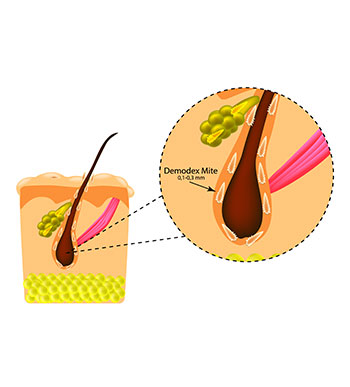

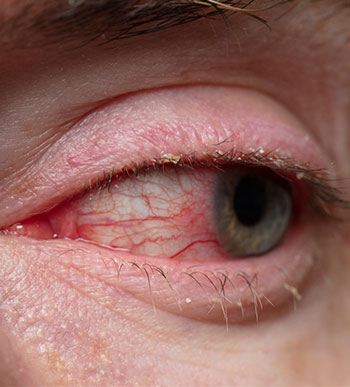
Diagnosing Dry Eye
The process of diagnosing ocular surface disease starts with a thorough discussion of medical history, symptoms you are experiencing, and your medications. From there, advanced diagnostic testing, performed in our office, provides the information needed to determine the cause of the problem. These tests include:
Eyelid Evaluation: Our doctors will examine your eyelids and tear film using a slit-lamp microscope to evaluate the quantity of your tears and the health of your eyelids.
TearLab osmolarity: Chronic evaporation of the water in the tears leaves a higher concentration of the remaining tear salts and other components behind. Tear salt concentration is measured to know if excessive tear evaporation is occurring.
LipiView meibography: Most cases of chronic dry eyes are caused by eyelid problems, specifically, meibomian gland dysfunction. Meibography is a unique type of imaging that scans the eyelid gland structure to determine if significant eyelid disease (meibomian gland loss) exists.
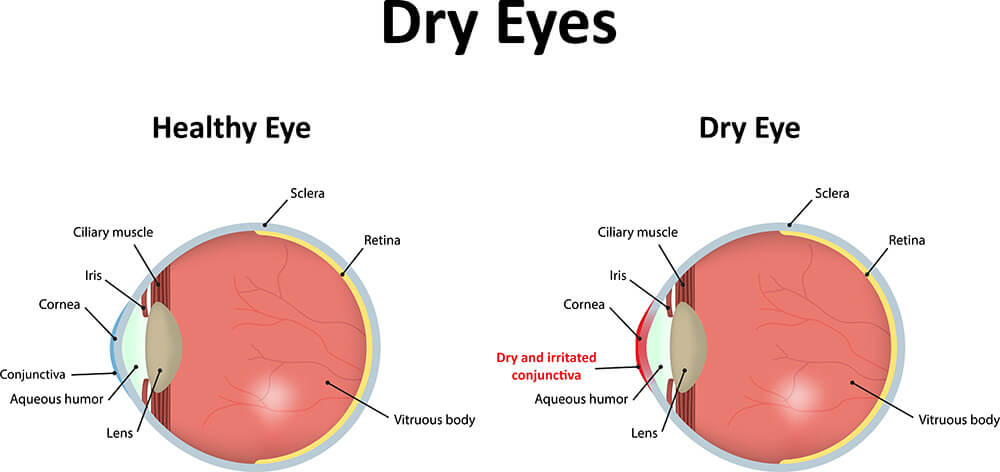
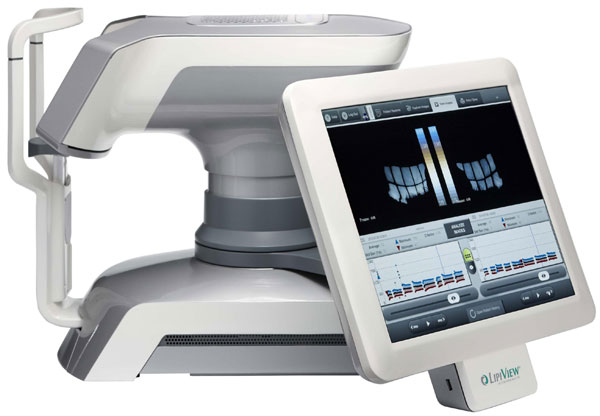

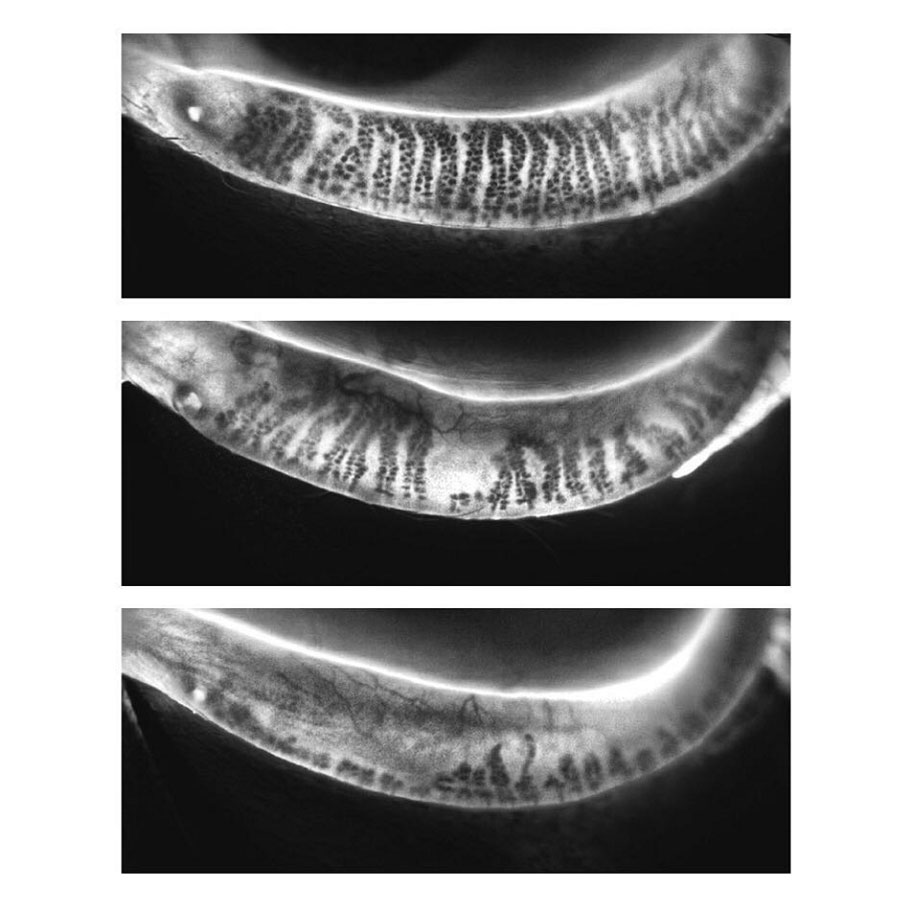
Dry Eye Treatments:
IPL & TriPollar
Dry eye treatments using IPL and TriPollar radiofrequency improve MGD (meibomian gland dysfunction – the most prevalent type of dry eye disease). Treating facial rosacea, which is the primary underlying cause of MGD, also improves erythema (facial redness), spider veins and other red spots. IPL and TriPollar radiofrequency improve and restore your skin to a healthier more youthful condition. Healthier skin means healthier eye lid glands which means less dry eye.
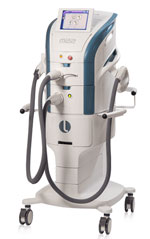
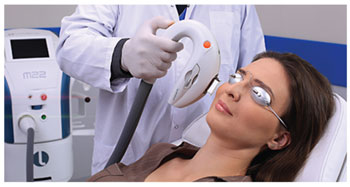
IPL – Lumenis M22
IPL (intense pulsed light) uses pulses of non-coherent light of specific wavelengths and energy that penetrate through your skin, creating heat and targeting skin imperfections in a controlled way. Your body’s natural healing process then removes the treated imperfections. IPL targets hemoglobin (red spots and spider veins) that are associated with ocular and facial rosacea and melanin (freckles & brown spots). IPL treatments significantly reduce the inflammation that is the the major cause of dry eye disease.
TriPollar – Legend Pro by Lumenis
TriPollar radiofrequency treats MGD dry eye disease by heating and removing the obstructions of thickened oil (meibum) in the meibomian glands of your eyelids. This treatment promotes normal function of the eyelid oil secreting glands. TriPollar also reduces facial rosacea, a major cause of inflammatory dry eye disease, stimulates collagen rejuvenation in the deeper layers of your skin and shrinks underlying fat cells.
IPL and Tripollar dry eye treatments also have aesthetic benefits.
For more information please visit Ageless Medical Aesthetics
LipiFLow
LipiFlow thermal pulsation is a treatment device specifically designed for effectively removing blockages from the meibomian glands, allowing them to properly function and produce the oils that make up the top protective lipid layer of the tear film. Supported by 37 patents and used around the world by leading eye care professionals, LipiFlow is the the standard of care for MGD with studies demonstrating its safe and effective results. LipiFlow was designed to minimize patient discomfort during a 12 minute in-office treatment that most patients describe as a gently massaging of the eye lids.
Intraductal Probing
A more advanced treatment option, intraductal probing (IDP) is performed when the meibomian gland openings are blocked by tissue adherence – in other words, when the glands have sealed their openings shut.
Blephex
Blephex is a device that “scrubs” the bacterial biofilm (like dental plaque) off your eyelid edges
Topical Medications
Eyedrops like Restasis and Xiidra are commonly prescribed to treat chronic dry eyes. In truth, only about 20% of chronic dry eye sufferers actually benefit from these medications. These medications are effective for inflammatory conditions stemming from Sjogrens syndrome, Lupus, Rheumatoid arthritis and other autoimmune conditions, however, they are not effective in treating meibomian gland disease – the most common type of dry eyes in which the tears evaporate too quickly.
Oral Medications
Inflammatory skin conditions (Rosacea) can sometimes be better controlled with low-dose Doxycycline. Treatments usually last for 90 days or longer.
Punctal Occlusion
Plugging the tear drain ducts in the eyelids can increase the volume of tears in the eyes. This treatment is typically considered when rehabilitative treatments fail.
Protective Contact Lenses
For very advanced dry eyes, when all standard therapies fail, large-diameter contact lenses called “scleral lenses” are used to provide protection to the eyes. These lenses require a doctor with extensive contact lens fitting experience.
Eyelid Heat Compresses
Using a heated compress helps to maintain normal function of the meibomian glands.
Learn More at Ageless Medical Aesthetics
If you want to learn more about IPL Treatments, visit the Ageless Medical Aesthetics Website.





